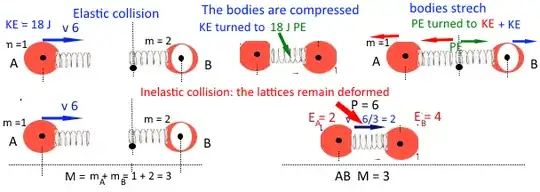Why is kinetic energy conserved in collision between glass balls while it is not conserved in collision between a ball and floor?
3 Answers
The difference is only in the properties of the material of a body. You can see in this video
- If it is elastic (happy ball) it can deform itself (thus absorbing KE) and then recover the original shape, giving back roughly the same amount of KE, which is considered as temporarily stored in the lattices

- If it is not elastic the body will stay deformed and the energy spent to deform it will never be recoverd. Another reason lays in the more difficult concept of hysteresis, which is explained here for an elastic band. In the video you see that the sad ball is not visibly deformed because hysteresis is great work done is dissipated in heat
No, the elasticity of the collision depends on a couple of factors.
1) the properties of the materials. The carpet is easily deformable, and the fibers are not elastic, if one removes the ball that fell they return to their original form after some time, or, even don't return. So, the kinetic energy of the falling ball does the work of deforming the fibers.
The glass doesn't behave like that. It cannot be deformed (unless the kinetic energy is very high - see point 2), but if the can be broken. Assume the case that the kinetic energy is not so high as to break the glass. Then, since there isn't an option that the kinetic energy transform in another form of energy, it is conserved.
2) the amount of kinetic energy at the contact between the two bodies. If the energy of the ball at the contact with the floor is much higher than the amount of energy needed to deform the fibers, then the fall on floor is almost an elastic process, the ball jumps back in the air.
As to the collision between two glass balls, for breaking the glass is needed an amount of energy sufficient for breaking the chemical bonds in the glass. I don't know the formula of the glass, it is not pure Silicon.
- 6,934
Energy is always conserved. In a collision between the ball and the floor, the ball looses some of the energy, that same amount is gained by the earth(supposing that the floor is attached to the earth). The amount of velocity gained by the earth, due to this collision, is very small(negligible) given its huge mass.
- 289